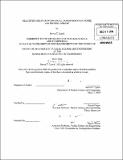Reactivity-equivalent physical transformation model for pin cell arrays
Author(s)
Lynch, Steven T. (Steven Tyler)
DownloadFull printable version (3.422Mb)
Other Contributors
Massachusetts Institute of Technology. Dept. of Nuclear Science and Engineering.
Advisor
Benoit Forget.
Terms of use
Metadata
Show full item recordAbstract
The behavior of TRISO fuel used in high temperature gas reactors in order to achieve high fuel performance is difficult to model using traditional lattice codes due to the double-heterogeneity effect created by the multi-coated fuel kernels in a graphite matrix. A simple volume-weighted homogenization does not accurately reduce the problem to one degree of heterogeneity as it does not properly account for the self shielding of the TRISO particles. The Reactivity-equivalent transformation (RPT) model, which condenses the TRISO fuel into a smaller fuel zone radius before homogenization, has been proposed as a possible solution to the problem of double-heterogeneity. The RPT method has been demonstrated to accurately model the reactivity of individual pin cells. While small, seven-cell RPT arrays are still highly accurate models of TRISO behavior, it is unclear if negligible error will extend to even larger arrays, especially in the presence of a B4C absorber. The validity of RPT array models was assessed by comparing the reactivity, thermal absorption, thermal utilization, resonance escape probability, fast fission factor, power, and neutron flux with reference values for an array containing all double-heterogeneous cells.
Description
Thesis (S.B.)--Massachusetts Institute of Technology, Dept. of Nuclear Science and Engineering, 2010. Cataloged from PDF version of thesis. Includes bibliographical references (p. 33).
Date issued
2010Department
Massachusetts Institute of Technology. Department of Nuclear Science and EngineeringPublisher
Massachusetts Institute of Technology
Keywords
Nuclear Science and Engineering.